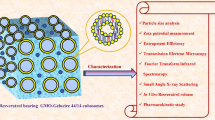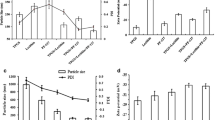Abstract
3-O-β-D-galactosylated resveratrol (Gal-Res) was synthesized from resveratrol (Res) and 3-O-β-D-galactose (Gal) in our previous study. In order to improve the pH sensitivity and bioavailability of Gal-Res, Gal-Res nanoparticles (Gal-Res NPs) were prepared using polydopamine (PDA) as a drug carrier. The drug loading (DL %) and entrapment efficiency (EE %) of Gal-Res NPs were 46.80% and 88.06%. The average particle size, polydispersity index (PDI), and Zeta potential of Gal-Res NPs were 179.38 ± 2.83 nm, 0.129 ± 0.013, and − 28.05 ± 0.36 mV, respectively. The transmission electron microscope (TEM) showed that Gal-Res NPs had uniform spherical morphology. Compared with the fast release of raw Gal-Res, the in vitro release of Gal-Res NPs was slow and pH-sensitive. The results of the blood vessel irritation and hemolysis test demonstrated that Gal-Res NPs had good hemocompatibility. The pharmacokinetics study in rats showed that area under the curve of plasma drug concentration time (AUC0→600) and half-life (t1/2) of Gal-Res NPs were enhanced 1.82-fold and 2.19-fold higher than those of raw Gal-Res. The in vivo biodistribution results showed that Gal-Res NPs were more distributed in liver tissue than Gal-Res. Gal-Res NPs with high bioavailability and liver accumulation were hopeful drug delivery systems (DDS) to treat liver diseases.
Graphical abstract







Similar content being viewed by others
References
Mukherjee S, Dudley JI, Das DK. Dose-dependency of resveratrol in providing health benefits. Dose-response. 2010;8:478–500.
Signorelli P, Ghidoni R. Resveratrol as an anticancer nutrient: molecular basis, open questions and promises. J Nutr Biochem. 2005;16(8):449–66.
Carrizzo A, Forte M, Damato A, Trimarco V, Salzano F, Bartolo M, et al. Antioxidant effects of resveratrol in cardiovascular, cerebral and metabolic diseases. Food Chem Toxicol. 2013;61(1):215–26.
Zhang H, Sun Q, Xu T, Hong L, Fu R, Wu J, et al. Resveratrol attenuates the progress of liver fibrosis via the Akt/nuclear factor-κB pathways. Mol Med Rep. 2016;13(1):224–30.
Ghinis-Hozumi Y, González-Dávalos L, Antaramian A, Villarroya F, Piña E, Shimada A, et al. Effect of resveratrol and lipoic acid on sirtuin-regulated expression of metabolic genes in bovine liver and muscle slice cultures. J Anim Sci. 2015;93(8):3820.
Heebøll S, El-Houri RB, Hellberg Y, Haldrup D, Pedersen SB, Jessen N, et al. The effect of resveratrol on experimental non-alcoholic fatty liver disease depends on severity of pathology and timing of treatment. J Gastroenterol Hepatol. 2016;31(3):668–75.
Meng F, Asghar S, Gao S, Su Z, Song J, Huo M, et al. A novel LDL-mimic nanocarrier for the targeted delivery of curcumin into the brain to treat Alzheimer’s disease. B Biointerfaces. 2015;134:88–97.
Jain A, Kesharwani P, Garg NK, Jain A, Jain SA, Jain AK, et al. Galactose engineered solid lipid nanoparticles for targeted delivery of doxorubicin. Colloids Surf B: Biointerfaces. 2015;134:47–58.
Sarika P, James N, Kumar P, Raj D. Galactosylated alginate-curcumin micelles for enhanced delivery of curcumin to hepatocytes. Int J Biol Macromol. 2016;86:1–9.
D'Souza A, Devarajan P. Asialoglycoprotein receptor mediated hepatocyte targeting - strategies and applications. J Control Release. 2015;203:126–39.
Wu D, Lu B, Chang C, Chen C, Wang T, Zhang Y, et al. Galactosylated fluorescent labeled micelles as a liver targeting drug carrier. Biomaterials. 2009;30(7):1363–71.
Qian J, Zha L, Wang B, Zhang C, Hong L, Chen W. Synthesis, cytotoxicity and liver targeting of 3-O-β-D-Galactosylated Resveratrol. J Pharm Pharmacol. 2019;71(6):929–36.
Ruiz-Gatón L, Espuelas S, Huarte J, Larraeta E, Martin-Arbella N, Irache JM. Nanoparticles from Gantrez AN-poly(ethylene glycol) conjugates as carriers for oral delivery of docetaxel. Int J Pharm. 2019;571:118699.
Dai X, Yao J, Zhong Y, Li Y, Bai T. Preparation and characterization of Fe3O4@MTX magnetic nanoparticles for thermochemotherapy of primary central nervous system lymphoma in vitro and in vivo. Int J Nanomedicine. 2019;14:9647–63.
Vora D, Heruye S, Kumari D, Opere C, Chauhan H. Preparation, characterization and antioxidant evaluation of poorly soluble polyphenol-loaded nanoparticles for cataract treatment. AAPS PharmSciTech. 2019;20(5):163.
Bernsmann F, Frisch B, Ringwald C, Ball V. Protein adsorption on dopamine-melanin films: role of electrostatic interactions inferred from zeta-potential measurements versus chemisorption. J Colloid Interface Sci. 2010;344(1):54–60.
Kwon I, Bettinger C. Polydopamine nanostructures as biomaterials for medical applications. J Mater Chem B. 2018;6(43):6895–903.
Jin A, Wang Y, Lin K, Jiang L. Nanoparticles modified by polydopamine: working as “drug” carriers. Bioact Mater. 2020;5(3):522–41.
Hasanzadeh M, Sadeghi S, Bageri L, Mokhtarzadeh A, Karimzadeh A, Shadjou N, et al. Poly-dopamine-beta-cyclodextrin: a novel nanobiopolymer towards sensing of some amino acids at physiological pH. Mater Sci Eng C Mater Biol Appl. 2016;1(69):343–57.
Zhong Z, Yao X, Gao X, Jia L. Polydopamine-immobilized polypropylene microfuge tube as a pH-responsive platform for capture/release of DNA from foodborne pathogens. Anal Biochem. 2017;534:14–8.
Hu J, Zhang X, Wen Z, Tan Y, Huang N, Cheng S, et al. Asn-Gly-Arg-modified polydopamine-coated nanoparticles for dual-targeting therapy of brain glioma in rats. Oncotarget. 2016;7(45):73681–96.
Umerska A, Paluch K, Santos-Martinez M, Corrigan O, Medina C, Tajber L. Freeze drying of polyelectrolyte complex nanoparticles: effect of nanoparticle composition and cryoprotectant selection. Int J Pharm. 2018;552:27–38.
Hong L, Li X, Bao Y, Duvall C, Zhang C, Chen W, et al. Preparation, preliminary pharmacokinetic and brain targeting study of metformin encapsulated W/O/W composite submicron emulsions promoted by borneol. Eur J Pharm Sci. 2019;133:160–6.
Li X, Yuan H, Zhang C, Chen W, Cheng W, Chen X, et al. Preparation andin-vitro/in-vivoevaluation of curcumin nanosuspension with solubility enhancement. J Pharm Pharmacol. 2016;68(8):980–8.
Wang B, Cheng W, Zhang C, Bao Y, Chen W. Self-assembled micelles based on gambogenic acid-phospholipid complex for sustained-release drug delivery. J Microencapsul. 2019;36(6):1–27.
de M Barbosa R, Ribeiro L, Casadei B, da Silva C, Queiróz V, Duran N, et al. Solid lipid nanoparticles for dibucaine sustained release. Pharmaceutics. 2018;10(4):231.
Huang S, Huang Z, Fu Z, Shi Y, Dai Q, Tang S, et al. A novel drug delivery carrier comprised of nimodipine drug solution and a nanoemulsion: preparation, characterization, in vitro, and in vivo studies. Int J Nanomedicine. 2020;15:1161–72.
Zha L, Qian J, Wang B, Liu H, Hong L. In vitro/in vivo evaluation of pH-sensitive Gambogenic acid loaded zein nanoparticles with polydopamine coating. Int J Pharm. 2020;587:119665.
Tang X, Sun J, Ge T, Zhang K, Gui Q, Zhang S, et al. PEGylated liposomes as delivery systems for Gambogenic acid: characterization and in vitro/in vivo evaluation. Colloids Surf B: Biointerfaces. 2018;172:26–36.
Hao J, Zhao J, Zhang S, Tong T, Zhuang Q, Jin K, et al. Fabrication of an ionic-sensitive in situ gel loaded with resveratrol nanosuspensions intended for direct nose-to-brain delivery. Colloids Surf B: Biointerfaces. 2016;147:376–86.
Hu Y, Yu C, Zhang H, Wang J, Jiang G, Kan C. pH-triggered drug release of monodispersed P(St-co-DMAEMA) nanoparticles: effects of swelling, polymer chain flexibility and drug-polymer interactions. J Nanosci Nanotechnol. 2017;17(2):900–7.
Tan G, Ouyang K, Lei Z, Yan L, Li FJ, W. The mechanism of pH-induced polydopamine films surface protonation and cell adhesion behavior. Sci Sin Chem. 2016;46:378–81.
Chang D, Gao Y, Wang L, Liu G, Chen Y, Wang T, et al. Polydopamine-based surface modification of mesoporous silica nanoparticles as pH-sensitive drug delivery vehicles for cancer therapy. J Colloid Interface Sci. 2016;463:279–87.
Lazarewicz J, Pluta R, Salinska E, Puka M. Beneficial effect of nimodipine on metabolic and functional disturbances in rabbit hippocampus following complete cerebral ischemia. Stroke. 1989;20(1):70–7.
Song X, Jiang Y, Ren C, Sun X, Zhang Q, Gong T, et al. Nimodipine-loaded mixed micelles: formulation, compatibility, pharmacokinetics, and vascular irritability study. Int J Nanomedicine. 2012;7:3689–99.
Li G, Zhao M, Zhao L. Well-defined hydroxyethyl starch-10-hydroxy camptothecin super macromolecule conjugate: cytotoxicity, pharmacodynamics research, tissue distribution test and intravenous injection safety assessment. Drug Deliv. 2016;23(8):2860–68.
Li L, Li W, Sun J, Zhang H, Gao J, Guo F, et al. Preparation and evaluation of progesterone nanocrystals to decrease muscle irritation and improve bioavailability. AAPS PharmSciTech. 2018;19(3):1254–63.
Santofimia-Castaño P, Salido G, Gonzalez A. Interferences of resveratrol with fura-2-derived fluorescence in intracellular free-Ca(2+) concentration determinations. Cytotechnology. 2016;68(4):1369–80.
Radi ZA. Kidney pathophysiology, toxicology, and drug-induced injury in drug development. Int J Toxicol. 2019;38(3):215–27.
Funding
The authors acknowledge the financial support from the National Natural Science Foundation of China (81703805, 51303006), the Provincial Natural Science Foundation of Anhui Province (1408085MH196, KJ2018ZD031), and the University excellent top-notch personnel training fund of Anhui Province (gxfx2017050).
Author information
Authors and Affiliations
Corresponding authors
Ethics declarations
Conflict of Interest
The authors declare no competing interests.
Additional information
Publisher’s Note
Springer Nature remains neutral with regard to jurisdictional claims in published maps and institutional affiliations.
Beilei Wang and Xiaoxiao Shan contributed to the work equally and should be regarded as co-first authors.
Supplementary Information
ESM 1
(DOC 1830 kb)
Rights and permissions
About this article
Cite this article
Wang, B., Shan, X., Lv, S. et al. Preparation, Characterization, and In Vitro/In Vivo Evaluation of 3-O-β-D-Galactosylated Resveratrol-Loaded Polydopamine Nanoparticles. AAPS PharmSciTech 22, 220 (2021). https://doi.org/10.1208/s12249-021-02079-7
Received:
Accepted:
Published:
DOI: https://doi.org/10.1208/s12249-021-02079-7




